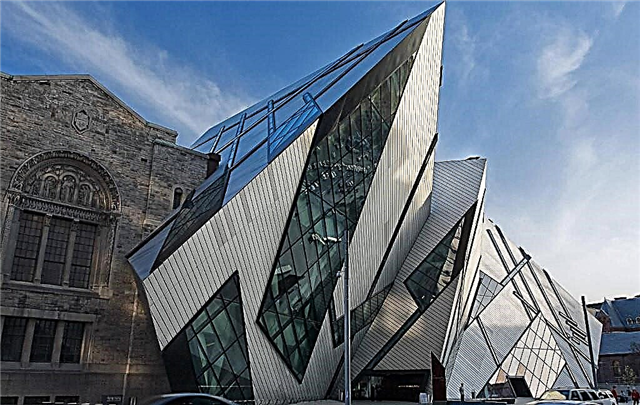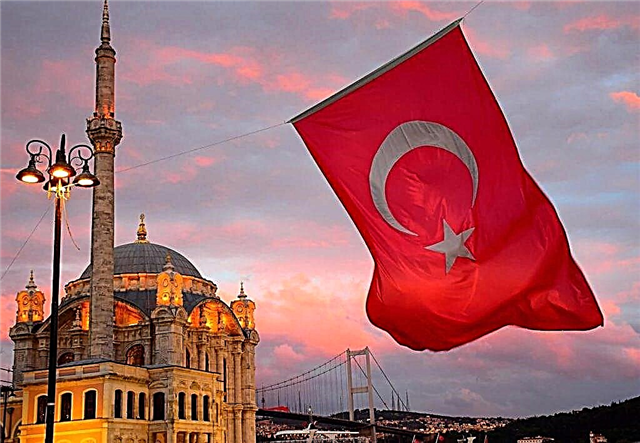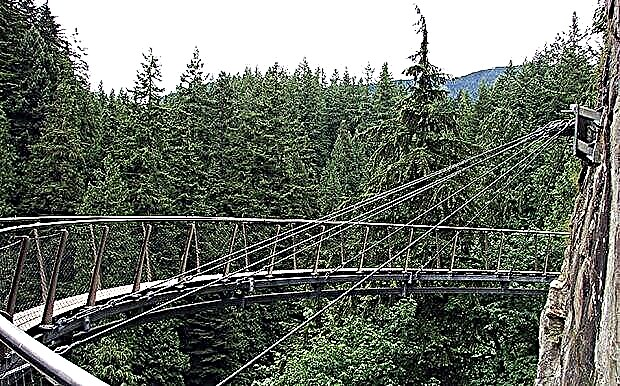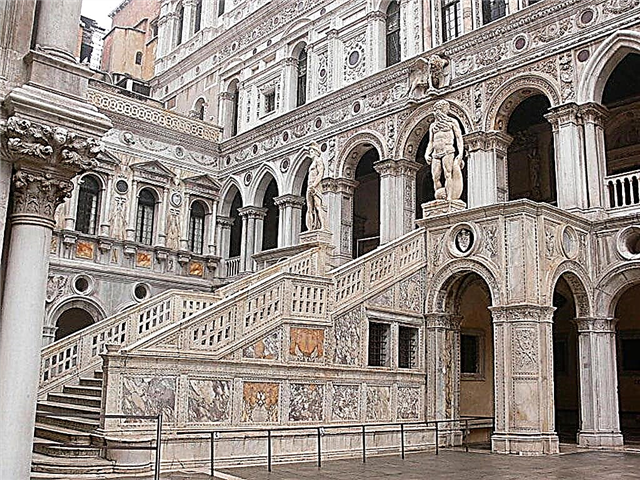In the center of Venice, where the waters of the Grand Canal flow into the lagoon, a grandiose palace rises. Its luxurious rooms are filled with memories of the past, triumphant and rich history of the Venetian Republic. This is the palazzo of the Doges - the rulers of a unique maritime empire. This amazing architectural wonder represents the symbol of statehood and is the main attraction of the city. In addition to the Doge's apartments, the building has spacious meeting rooms for senators, magisters and supreme justices.
Today, the Doge's Palace is the most famous museum in Venice. Visitors are given the opportunity to enter the halls and rooms where political issues and the fate of the Venetians were decided. An indelible impression in the memory of tourists is left by the decorated facade and interior decoration of the palazzo.
Construction history

By the end of the 10th century, Venice became a powerful maritime power led by the Doge. At that time, his residence looked like a simple, no-frills wooden structure surrounded by a large wall with towers. The insular position of Venice determined the emergence of a special state structure and identity in politics. Over the course of several centuries, a complex system of government was gradually formed, combining monarchy, oligarchy and democracy. The privileged local communities elected the head of the republic - the doge. He was in fact a ruler with limited powers. The real leadership of Venice was exercised by the nobility, in particular the Grand Council and the Senate.
The ancient palace closed with defensive fortifications did not correspond to the new system of leadership of the republic with its expanded economic and political capabilities. Venice was defended by a combat fleet, so there was no need to build a powerful fortress. The city needed a building that would be able to place the entire government apparatus of the legislative, executive and judicial branches in one place.
Since 1309, the construction of the palace in the Gothic style began. The emergence of the newest trends of that period in architecture and art was marked by the gradual expansion of the area of the halls of the palazzo, the construction of new buildings and the decoration of the facade with elegant architectural elements of decor. Venetian artists and craftsmen were involved in decorating the palace in the form of sculptures and frescoes. In 1424, the palazzo acquired an unusual cubic shape with a courtyard. In the 16th century, fires damaged the residence several times, leading to new construction and restoration of the façade.
The main concept of the Doge's Palace was to instill in the surrounding world the concept of the independence, grandeur and financial well-being of Venice. The combination of austerity, airiness and sophistication of forms in architecture should have left an indelible impression in the eyes of foreign ambassadors. After the fall of the Venetian Republic, the Doge's Palace lost its powerful significance. Before joining Italy in 1866, the city was under the protectorate of France and then Austria-Hungary. The palazzo was converted into a library, and some of the halls were occupied by commercial enterprises.
At the end of the 19th century, at the initiative of the Italian authorities, a comprehensive reconstruction was carried out: many of the columns were replaced, sculptures and frescoes were restored. The building is transferred to the state administration for the protection of monuments. Since 1923, the palace has been officially a museum.
Architecture and style
The appearance of the architectural masterpiece is unusual. One façade of the Doge's palace overlooks the lagoon and the other overlooks St. Mark's Square. The massive, austere building rests on light openwork colonnades. The entire lower floor is full of round arches. The second tier is represented by a row of thin columns forming an open loggia. Passing arcades add sophistication to the architectural style. The capital of each column is decorated with carved sculptures. Colonnades in the Gothic style are gracefully combined with oriental décor.

The central part of the palazzo is decorated with a large balcony overlooking the statue of Justice. The upper part of the palace is a smooth wall with large vaulted windows. The roof is crowned with a jagged cornice, where small pointed turrets with intricate ornamentation rise. The facade is clad in pink, white and gray marble.
The main entrance to the palace is a gate framed with decorative patterns, spiers and bas-reliefs. Above them rises the sculpture of the Doge Francesco Foscari, who kneels before a winged lion. On the sides of the gate, there are statues of young women symbolizing strength and mercy. Passing under a pointed arch, visitors have a majestic view of the Giants' Staircase. Its steps lead to large sculptures of Mars and Neptune, considered the patrons of Venice.

The inner courtyard of the palazzo is surrounded by marble arcades, and in the center there are two bronze small pools with spring water. Here you can see many different sculptures of biblical characters, philosophers and scientists of Ancient Greece.
Halls
The palace consists of several buildings: the Doge's residence, the Halls of Justice and the Grand Council. The palazzo impresses with an abundance of rooms, each of which has its own name and purpose. The walls and ceilings of the chambers are adorned with magnificent paintings, statues and stucco moldings. The finest sculptures and artists of medieval Italy were involved in interior decoration. Painting in the halls was of sacred importance for members of the government. Through pictorial allegory, Venice's state decisions were glorified and idealized.

The largest room in the palace is the Grand Council Hall. It is 53 meters long and 25 meters wide. More than 2,000 noble Venetians could sit here at the same time, discussing the current problems of the country. Behind the throne of the Doge, the art canvas "Paradise" with dimensions of 22 x 7 m, glorifying the beauty of Venice, rises. The walls and ceiling are painted with paintings bordered with gilded patterns. They depict scenes of military exploits of the Venetians on land and at sea.

The Doge's study is decorated with a carved wooden ceiling, picturesque friezes, stucco moldings and a marble fireplace. Upholstered furniture covered with golden velvet fabric, lacquered table and mirrors give the room a special sophistication. In the Senate Hall, you can see unique panels of the famous Venetian artist Tintoretto, painted on the ceiling. The main figures of the paintings are the image of Christ and the doge. This is a kind of hint that the senators responsible for the economy and foreign policy of Venice were under the tutelage of the son of God.
Visitors to the museum will certainly be amazed by the pompous painting by G. Tiepolo in the Hall of the Four Doors called "Venice accepts the gift of Neptune." The artist gracefully depicted Venice in the image of a woman with a royal mantle, at whose feet Neptune pours gold coins from a bowl. Members of the Venice government who investigated crimes against the state sat in the Council Chamber of Ten. The ceiling of this room is divided by carved gilded frames with canvases interpreting mythological trials.
The room where the masters met is framed by canvases by the Dutch artist Hieronymus Bosch. The paintings depict satire over human vices, temptation and atonement for sin. The Doge's Palace is striking in its versatility. In addition to working rooms for the authorities, there are two prisons in the building. One with lead walls under the roof and the other in the basement at water level.Famous prisoners of the Palazzo Doges were Giordano Bruno and Giacomo Casanova.
Opening hours and cost of tickets to the palace
The Palazzo Doge opens its hospitable gates for visitors from 8:30 to 19:00 (in the warm season from April to October) and until 17:30 (in the cold season from November to March). The cost of a single ticket with access to all halls is 20 euros.
Where is it located and how to get there
The palace is located in the area of St. Mark's Square, where the main attractions of Venice are concentrated, so it is quite easy to get to the architectural structure. Water buses (vaporettos) sail here, plowing the waters of the Grand Canal. Near the palazzo there is a marina where ferries and passenger liners arrive.











